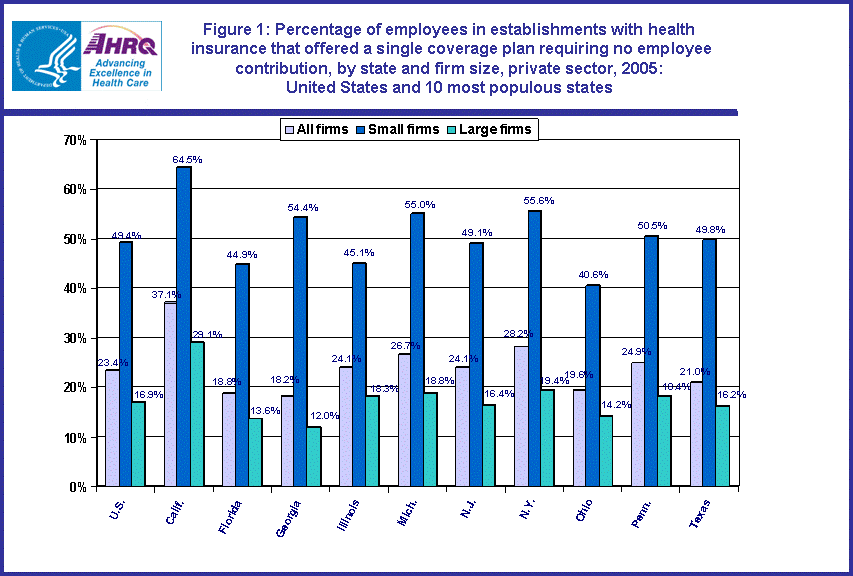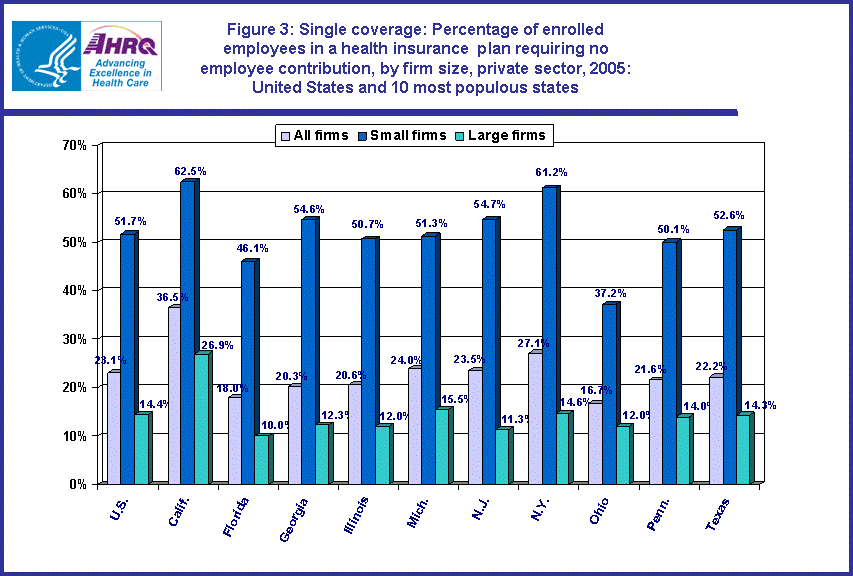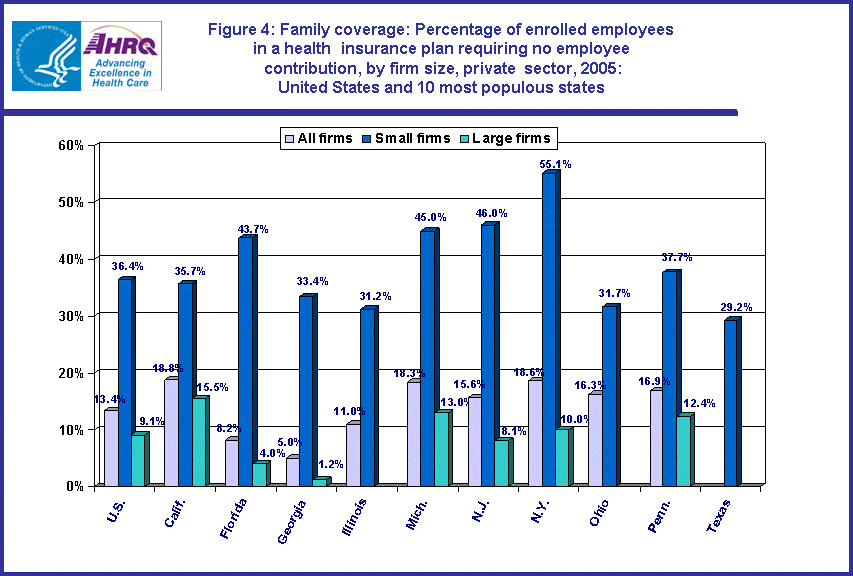
|
|
Font Size:
|
||||
|
|
|
|
||||
STATISTICAL BRIEF #213:
State Differences in Offer Rates and Enrollment in Employer-Sponsored Health Insurance Plans That Required No Employee Contribution to the Premium Cost, 2005
Highlights
- 23.4 percent of employees in establishments offering health insurance worked in firms that offered at least one plan where the employee made no contribution to the cost of health insurance premiums for single coverage. Of the ten most populous states, California had the highest percentage (37.1 percent).
- For small firms in the U.S. that offered insurance, almost half (49.4 percent) of all employees were offered at least one plan with no employee contribution for single coverage.
- Of all employees in the U.S. who were enrolled in employer-sponsored health insurance with single coverage, the percent in plans that required no employee contribution was 23.1 percent. California had the highest percentage (36.5 percent) enrolled in no employee contribution plans with single coverage, while Florida (18.0 percent) and Ohio (16.7 percent) had the lowest.
- Employees in small firms were much more likely than those in large firms to be enrolled in a plan that required no contribution to the premium. Over one-half of employees enrolled in a single coverage plan in small firms were in plans with no required premium contribution by employees; the same was true for over one-third of those with family coverage in small firms.
- In New York over one-half (55.1 percent) of all employees enrolled in a family plan in small firms were in plans with no required premium contribution by employees.
Introduction
While many employers have cut back their health insurance benefits in response to rising costs, some employers continue to pay 100 percent of premiums for their employees. In 2005, almost one-quarter of employees in establishments with health insurance worked in firms that offered at least one plan where the employer required no employee contribution to the health insurance premium for at least one plan with single coverage.
This Statistical Brief presents estimates of offer rates and enrollment in employer-sponsored health insurance plans requiring no employee contribution in the ten most populous states in 2005. The availability of such plans varies considerably by state and firm size, among other factors. State variations from the national average are discussed.
The estimates shown in this brief, which are drawn from the Insurance Component of the Medical Expenditure Panel Survey (MEPS-IC), look at both single and family coverage in the private sector of the economy. In addition to all firms, estimates for employees working for small (less than 50 employees) and large (50 or more employees) firms are shown. All differences between estimates discussed in the text are statistically significant at the 0.05 level.
Findings
Offer rates
Among the 112.2 million private sector employees in the United States in 2005, 97.5 million, or 86.9 percent, worked where employer-sponsored health insurance was offered (see Statistical Brief #178). Of these, 23.4 percent of employees in establishments with health insurance worked in firms that offered at least one plan where the employee made no contribution to health insurance premiums for single coverage (figure 1).
Of the 10 most populous states, California had the highest percentage (37.1 percent) of employees who worked in firms that offered insurance and that required no employee contribution to single health insurance premiums for at least one plan. Employees in New York (28.2 percent) were also offered such plans at a higher rate than the national average; the offer rate in Florida (18.8 percent) was below the national average.
Overall, 11.9 percent of employees (in firms that offered insurance) were offered at least one family coverage plan that required no employee contribution (figure 2). This percentage was higher than the national average in California, Michigan, New Jersey, and New York. It was lower than the national average in Florida.
For small firms in the U.S. that offered insurance, almost half (49.4 percent).of all employees were offered at least one plan requiring no employee contribution for single coverage. In nine of the 10 most populous states, the offer rates of at least one single coverage plan with no employee contribution did not differ significantly from the national average. Only in California was the rate different; almost two-thirds of employees in small firms with insurance were offered a no employee contribution single plan.
Slightly over one-quarter of all employees in small firms in the U.S. that offer insurance were offered at least one family plan with no employee contribution to the premium. The rate was higher in New York (38.3 percent) and lower in Georgia (18.8 percent).
The percentage of employees in large firms with insurance who were offered at least one no employee contribution plan was much lower than for those in small firms, for both single (figure 1) and family (figure 2) plans. Nationwide, 16.9 percent of employees in large firms with insurance were offered a single coverage plan which did not require an employee contribution towards health insurance premiums. The rate was similar in most of the 10 most populous states; only in California was the rate significantly different, with 29.1 percent of employees in large firms offered such plans.
In large firms where health insurance was offered, the percentage of all private sector employees in the U.S. who were offered at least one no employee contribution plan with family coverage was 8.3 percent. Workers in Michigan (14.9 percent) and New York (12.0 percent) were more likely to be offered a family plan which required no employee contribution for health insurance premiums.
Enrollment
Of all employees in the U.S. who were enrolled in employer-sponsored health insurance with single coverage, the percent in plans that required no employee contribution was 23.1 percent (figure 3). California had the highest percentage (36.5 percent) enrolled in no employee contribution plans with single coverage, while Florida (18.0 percent) and Ohio (16.7 percent) had the lowest.
Employees in small private sector firms were much more likely than those in large firms to be enrolled in a plan that required no contribution to the premium. Over one-half of all employees enrolled in a single coverage plan in small firms were in plans with no required premium contribution by employees. California (62.5 percent) and New York (61.2 percent) had significantly different rates for single coverage, and both were higher than the national average. Over one-third (36.4 percent) of enrolled employees in small firms made no contribution to their family premium (figure 4). The rate in New York (55.1 percent) was higher than the national average.
For large employers, 14.4 percent of employees with single coverage were in plans that required no employee contribution. California had a higher rate of such employees (26.9 percent), while employees in Florida were enrolled at a lower rate (10.0 percent) (figure 3). The percentage enrolled in family plans was generally lower. Overall, 9.1 percent of employees in large firms with family coverage (figure 4) were enrolled in plans which required no contribution towards premiums by the employee. These rates were higher in California (15.5 percent) and Michigan (13.0 percent).
Data Source
This Statistical Brief summarizes data from the 2005 MEPS-IC. The data are available on the MEPS Web site (http://www.meps.ahrq.gov) or have been produced using special computation runs on the confidential MEPS-IC data available at the U.S. Census Bureau.
Definitions
Employer
A particular workplace or physical location where business is conducted or services or industrial operations are performed. In this brief, only private sector employers are reported.
Employee
A person on the actual payroll. This definition excludes temporary and contract workers but includes the owner or manager if that person works at the firm.
Enrollee
An employee that is enrolled in a health insurance plan offered by the employer. Enrollees do not include any dependents covered by the plan.
Firm
A business entity consisting of one or more business establishments under common ownership or control. A firm represents the entire organization, including the company headquarters and all divisions, subsidiaries, and branches. A firm may consist of a single-location establishment, in which case the establishment and firm are identical.
Health insurance plan
An insurance contract that provides hospital and/or physician coverage to an employee for an agreed-upon fee (premium) for a defined benefit period.
Single coverage
Health insurance that covers the employee only.
Family coverage
Health insurance that covers the employee and the employee's family. Information is collected for a family of four when family plans vary by family size.
About MEPS-IC
The MEPS-IC is a survey of business establishments and governments that collects information on employer-sponsored health insurance, such as whether insurance is offered, enrollments, types of plans, and premiums. The survey is conducted annually by the U.S. Census Bureau under the sponsorship of the Agency for Healthcare Research and Quality (AHRQ). The yearly response rate has averaged 78 percent for in-scope sample units. Approximately 4 percent of the original sample has been out-of-scope in a typical year. A total sample of 42,000 private sector establishments was selected for the 2006 survey, prior to accounting for losses due to nonresponse and out-of-scope cases.
For more information on this survey, see MEPS Methodology Reports 6, 8, 10, 14, 17 and 18 on the MEPS Web site at http://www.meps.ahrq.gov/data_stats/publications.jsp and Insurance Component Survey Basics at http://www.meps.ahrq.gov/survey_comp/Insurance.jsp.
Suggested Citation
Amy K. Taylor, PhD and Beth Levin Crimmel, MS. State Differences in Offer Rates and Enrollment in Employer-Sponsored Health Insurance Plans That Required No Employee Contribution to the Premium Cost, 2005, Statistical Brief #213. July 2008. Agency for Healthcare Research and Quality, Rockville, MD, http://www.meps.ahrq.gov/data_files/publications/st213/stat213.pdf
AHRQ welcomes questions and comments from readers of this publication who are interested in obtaining more information about access, cost, use, financing, and quality of health care in the United States. We also invite you to tell us how you are using this Statistical Brief and other MEPS data and tools and to share suggestions on how MEPS products might be enhanced to further meet your needs. Please e-mail us at mepsprojectdirector@ahrq.hhs.gov or send a letter to the address below:
Steven B. Cohen, PhD, Director
Center for Financing, Access, and Cost Trends
Agency for Healthcare Research and Quality
540 Gaither Road
Rockville, MD 20850
 |
||||||||||||||||||||||||||||||||||||||||||||||||||||||||||||||||||||||||
|
||||||||||||||||||||||||||||||||||||||||||||||||||||||||||||||||||||||||
|
|
||||||||||||||||||||||||||||||||||||||||||||||||||||||||||||||||||||||||
 |
||||||||||||||||||||||||||||||||||||||||||||||||||||||||||||||||||||||||
|
||||||||||||||||||||||||||||||||||||||||||||||||||||||||||||||||||||||||
|
|
||||||||||||||||||||||||||||||||||||||||||||||||||||||||||||||||||||||||
 |
||||||||||||||||||||||||||||||||||||||||||||||||||||||||||||||||||||||||
|
||||||||||||||||||||||||||||||||||||||||||||||||||||||||||||||||||||||||
|
|
||||||||||||||||||||||||||||||||||||||||||||||||||||||||||||||||||||||||
 |
||||||||||||||||||||||||||||||||||||||||||||||||||||||||||||||||||||||||
|
||||||||||||||||||||||||||||||||||||||||||||||||||||||||||||||||||||||||
|
|
||||||||||||||||||||||||||||||||||||||||||||||||||||||||||||||||||||||||


